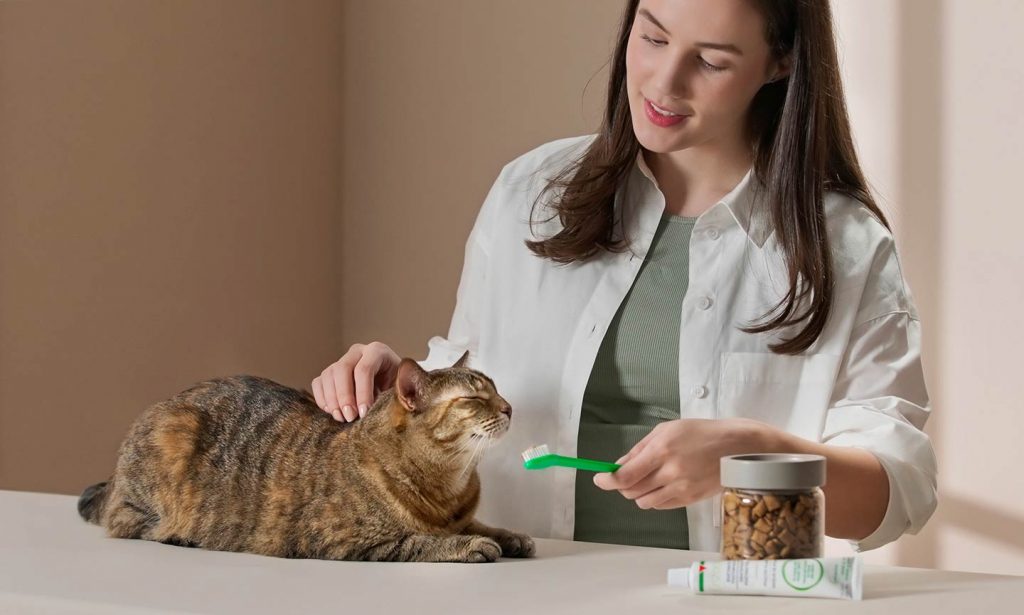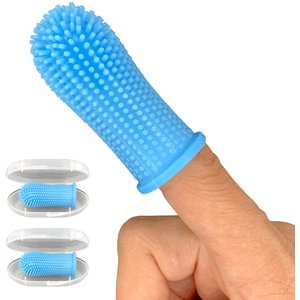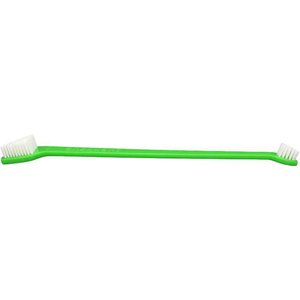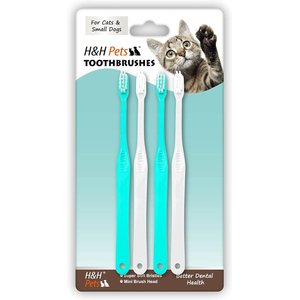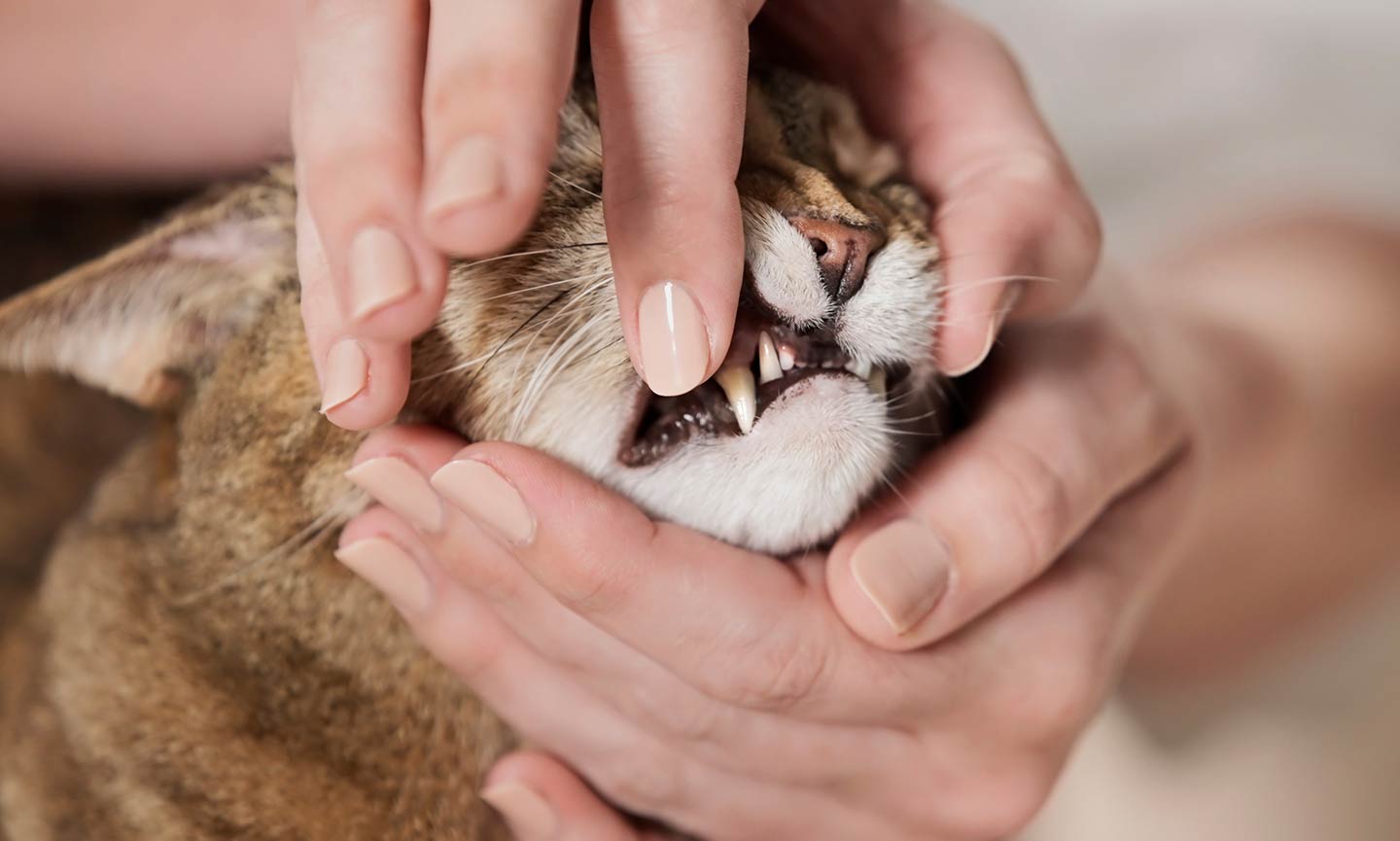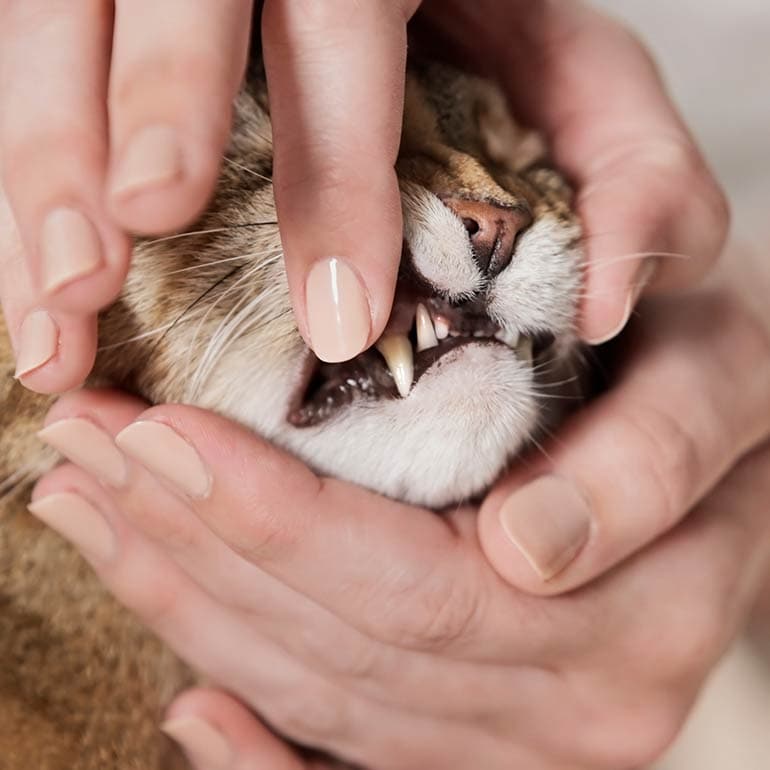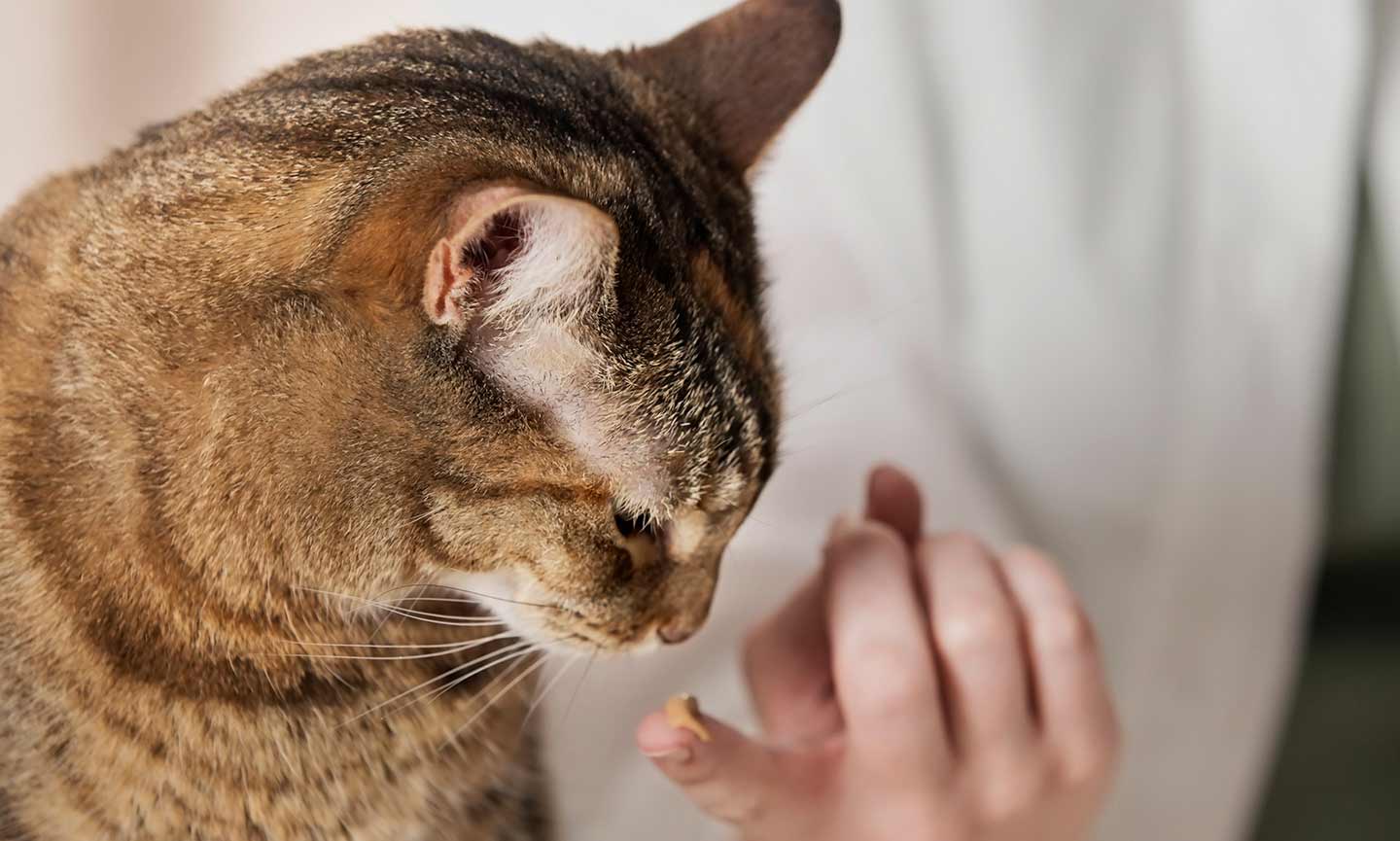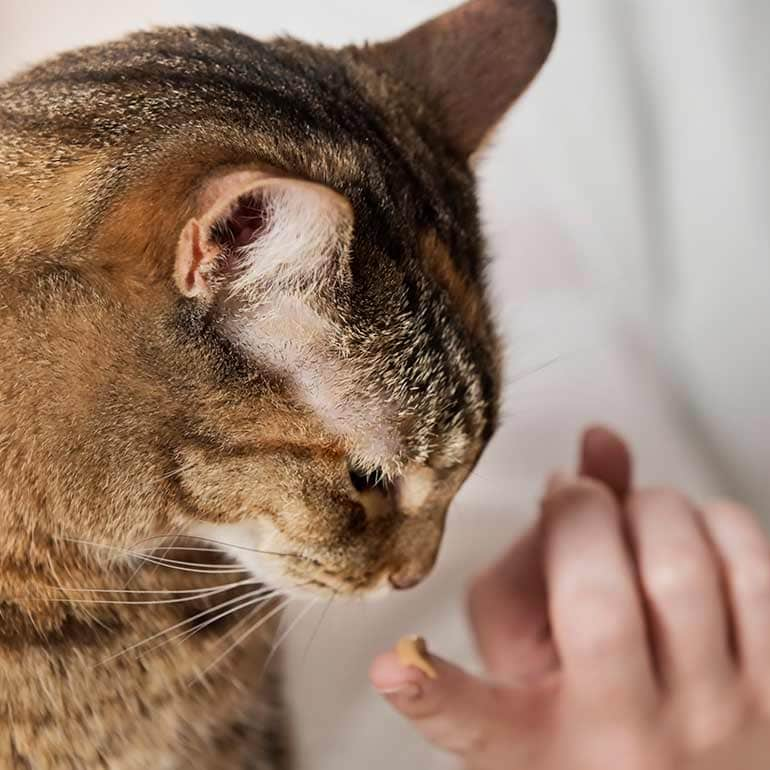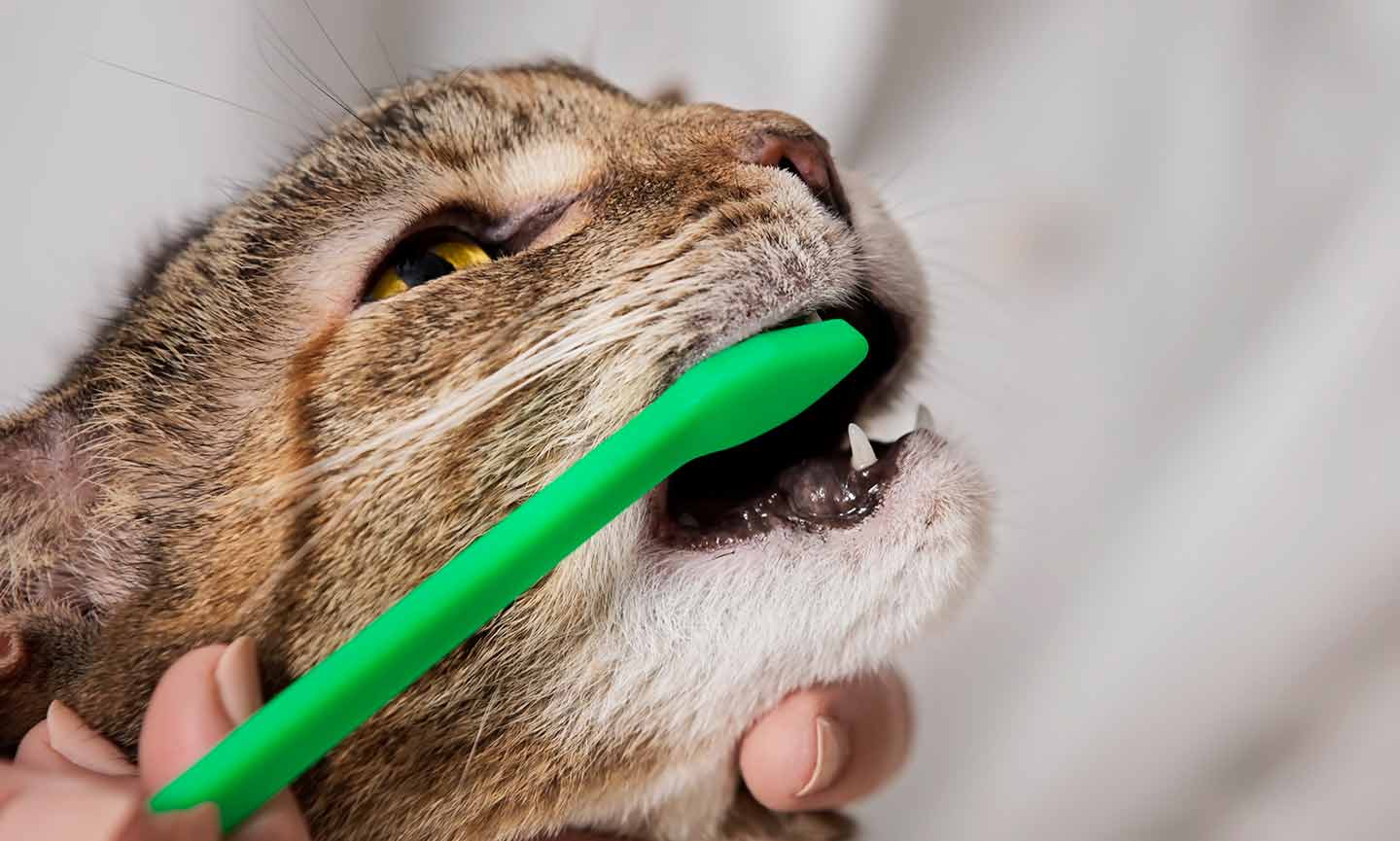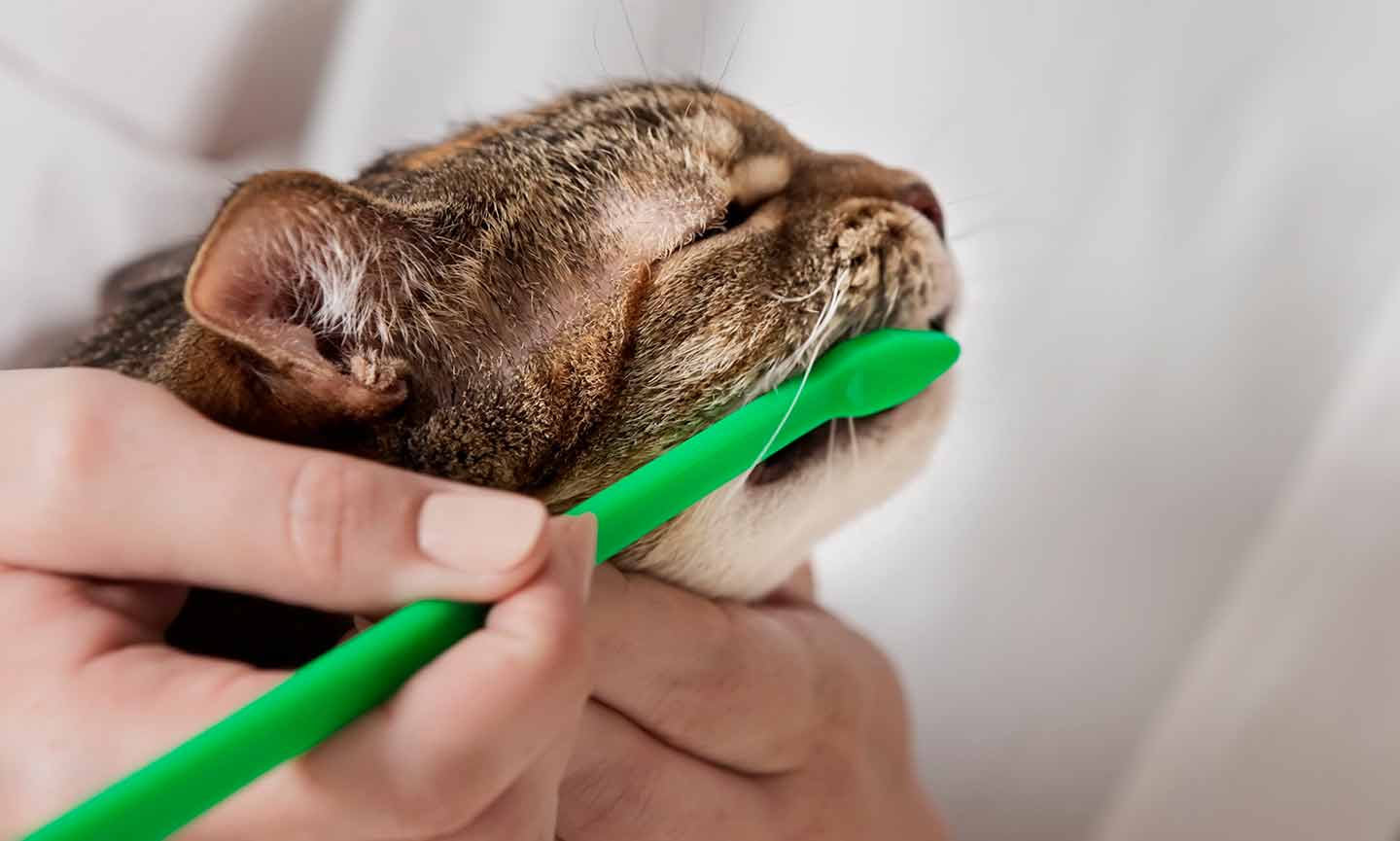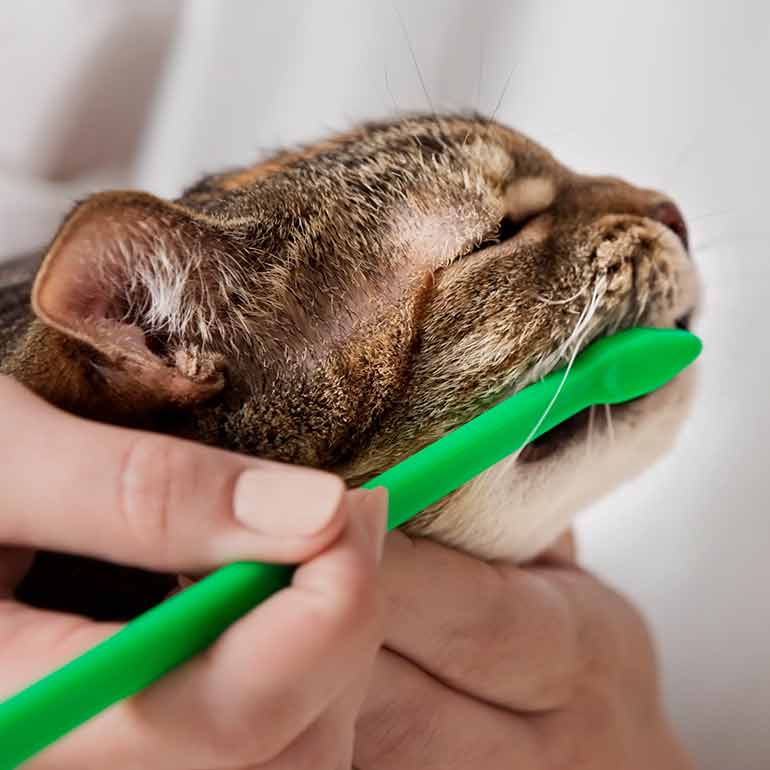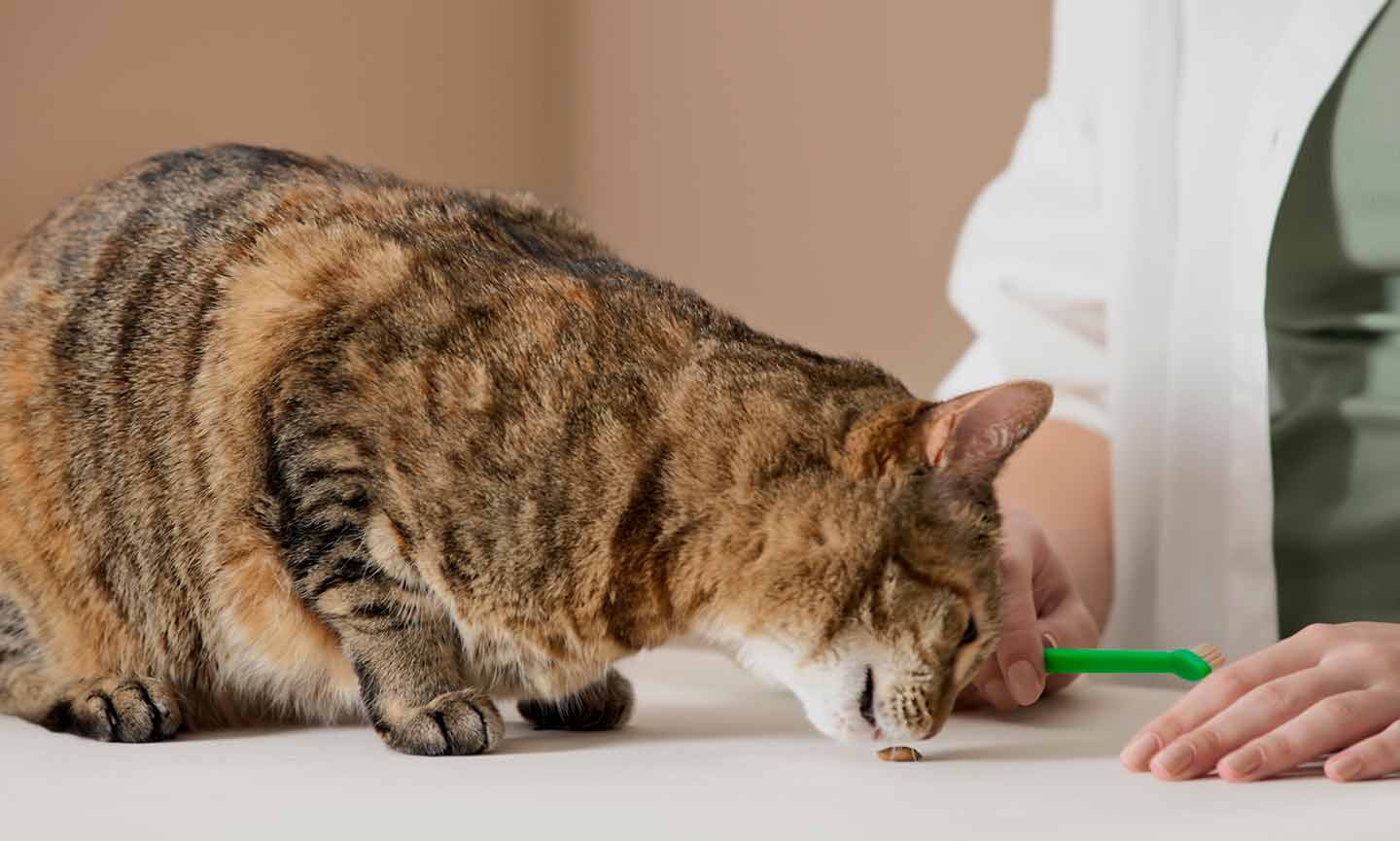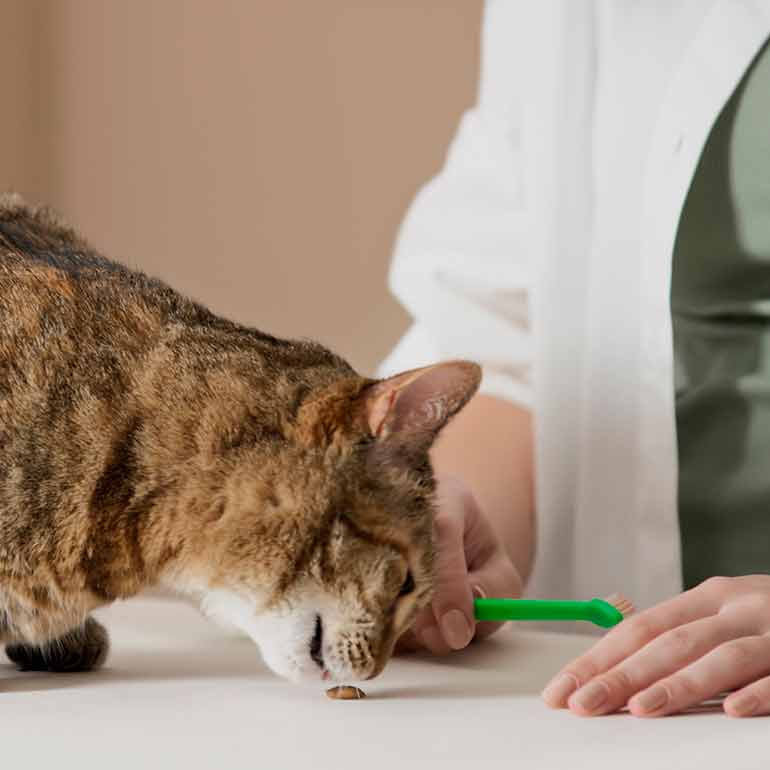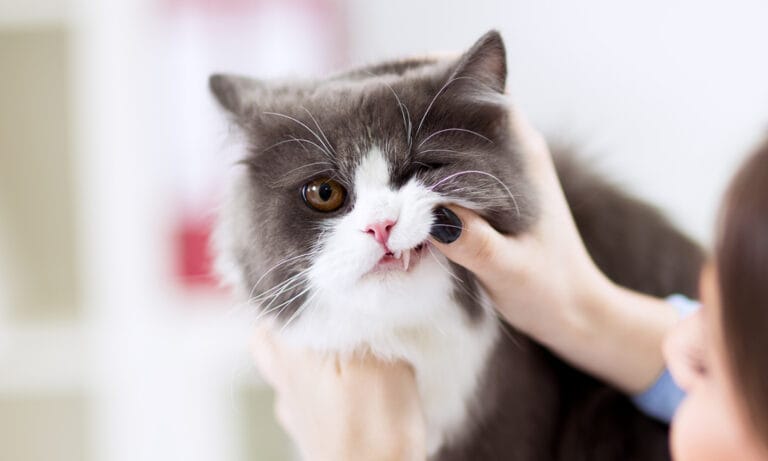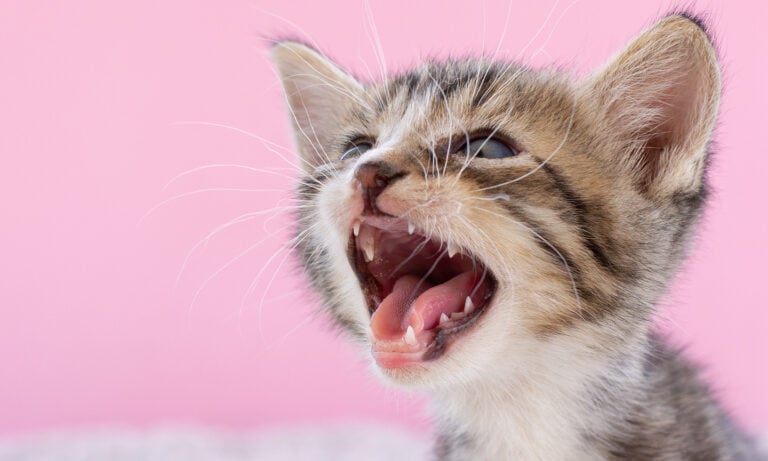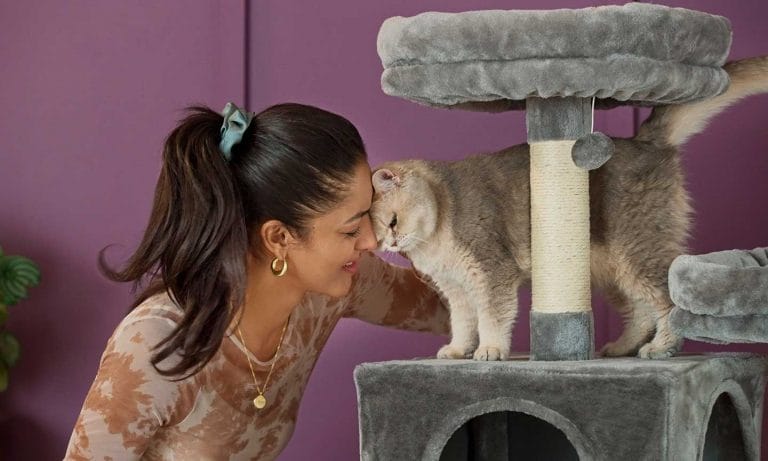Ah, the dreaded task of cleaning cats’ teeth. When most cat parents think about sticking a cat toothbrush into their kitty’s fanged mouth, they probably imagine ending up with deep, long scratches and gashes on their arms.
“Brushing your cat’s teeth is not for the faint of heart,” says veterinarian and pet chiropractor Laurie Coger, DVM, of The Healthy Dog Workshop.
And while scratches can certainly happen—especially if you approach this necessary part of pet health the wrong way—with the right technique and tools, you can learn how to brush your cat’s teeth, make at-home cleanings a pleasant experience for everyone and help make dental health upkeep a breeze.
In This Guide
Should I Brush My Cat’s Teeth?
Is a dental care routine really necessary for cats? Due to cats’ naturally independent nature, brushing their teeth may seem downright impossible and can easily be overlooked.
However, brushing a cat’s teeth is, in fact, necessary to maintain their oral health and overall wellness, according to experts Dr. Bethany Hsia, DVM, co-founder of CodaPet in Clovis, California, and Dr. Sabrina Kong, DVM, Certified Canine Rehabilitation Practitioner at Jules Veterinary Center in Tracy, California.
“Regular brushing helps prevent dental diseases like gingivitis, periodontitis and tartar buildup,” Dr. Kong says.
A lack of dental care has the same risks for cats as it does for humans: plaque and tartar buildup. This can lead to various dental diseases and, if left untreated, can cause:
- Pain
- Difficulty eating
- Oral infections
- Heart and kidney complications
“The risks of tooth brushing are minimal, mainly involving the cat’s tolerance to the activity,” Dr. Kong says. “Gradual acclimatization and positive reinforcement can mitigate these risks.”
What You’ll Need to Brush Your Cat’s Teeth
Before you begin brushing your cat’s teeth, you’ll need to gather all your tools and supplies. Below, we’ve created this handy shopping list of clean-mouth, cat dental care must-haves.
The Best Cat Toothbrushes
Because cats have tiny little mouths and teeth, look for a tiny brush sized just for cats, recommends Bert Gaddis, DVM, dipl. AVDC, owner of Animal Dental Specialists in Pelham, Alabama.
You can find special cat toothbrushes with single heads, double heads and even some that fit on the tip of your pinky finger.
The Best Kitten Toothbrushes
If fully-grown cats have a small mouth, kittens' mouths are itty-bitty. When shopping for the perfect kitten toothbrush, Dr. Hsia says to consider brushes specifically designed for, well, kittens!
The best options for your kitty should have soft bristles to prevent causing any discomfort or damage to their sensitive gums, as well as a small head and long handle so you can easily reach all areas of their mouth during your toothbrushing session.
Not sure whether your kitten will tolerate a toothbrush? Worry not. Dr. Kong says finger toothbrushes can be a good starting point, as they allow for better control and are less intimidating for kittens.
Cat Toothpaste
Pet toothpaste comes in flavors, like poultry and fish, that cats find irresistible. The toothpaste contains special enzymes that break down food and bacteria.
Can you use human toothpaste on cats? No. Do not use human toothpaste on your feline friend, because many brands contain fluoride, detergents and artificial sweeteners like xylitol that can be harmful to pets, Dr. Gaddis says.
You should also have some of your kitty’s favorite treats and toys on hand to reward them for a job well done.
The Best Kitten Toothpaste
As with any other pet care product, it’s important to look for a kitten toothpaste that’s specifically formulated for cats, Dr. Kong says. The toothpaste should also be free of fluoride, xylitol and other ingredients that can be harmful to cats. Case in point, fluoride can be toxic to cats if swallowed in large amounts, Dr. Hsia says.
Additionally, you’ll want an enzymatic toothpaste to break down plaque and tartar. And of course, what would a pet toothpaste be without odd-to-us but oh-so-yummy flavors for our kittens? Toothpaste flavors like fish or poultry can make kittens tolerate—and maybe even enjoy—getting their teeth brushed.
Is Toothpaste Bad for Cats?
Not sure whether you can, or should, share your toothpaste with your kitty?
Dr. Hsia says human toothpaste should never be used on cat teeth. This is because our toothpaste contains ingredients, like xylitol and fluoride, that are harmful to cats. In some cases, “xylitol” may not be on the ingredients list but is actually present under another name, including “birch sugar,” “birch bark extract” or “wood sugar.” No matter the name, this sweetener is toxic to cats and should always be avoided.
“Even if a cat enjoys the smell of human toothpaste, it is crucial to use toothpaste specifically formulated for cats to ensure their safety,” Dr. Hsia says.
How to Brush Cats’ Teeth: Step-by-Step Instructions
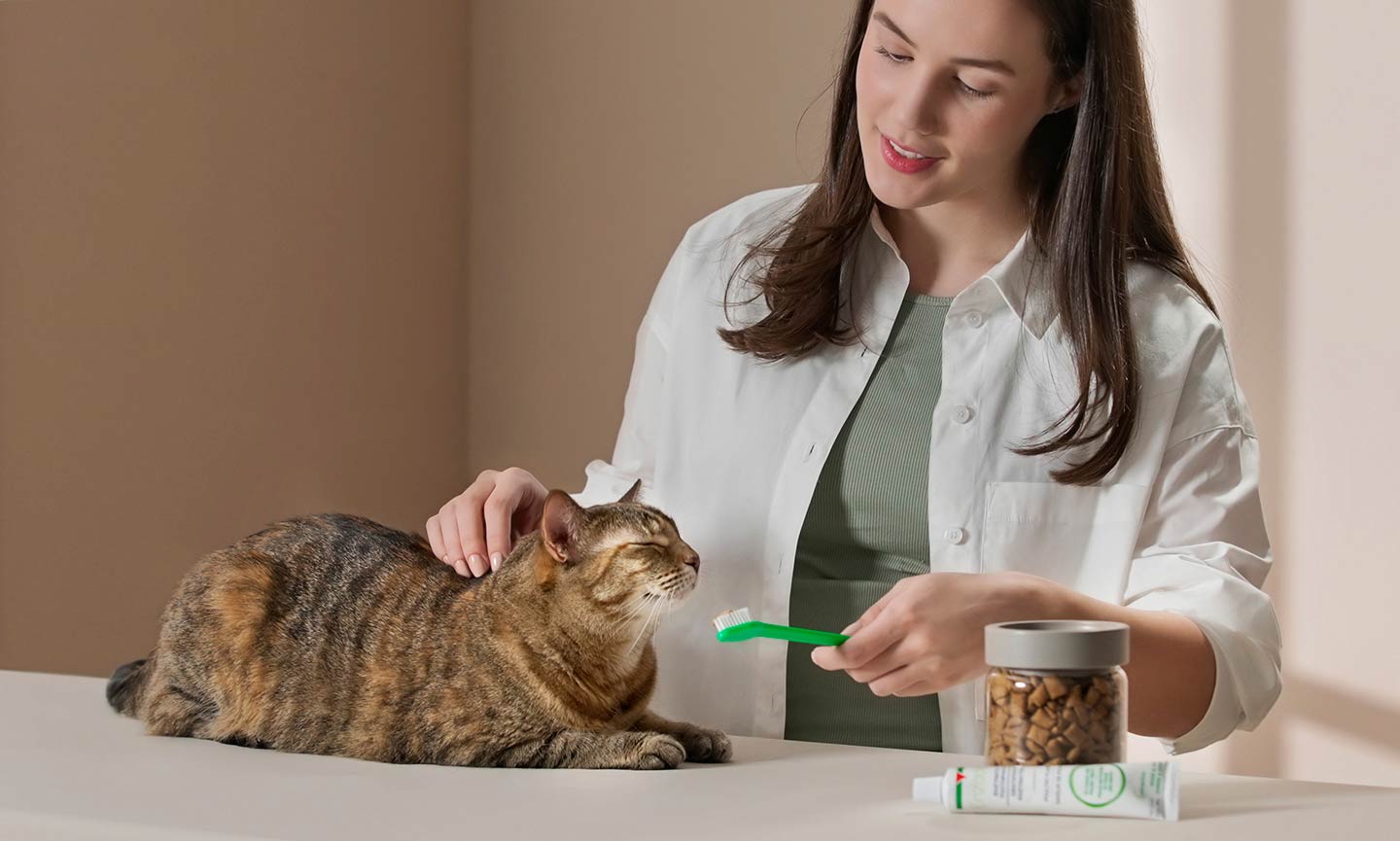
If you’ve asked yourself, “Should I brush my cat’s teeth?” The answer is a resounding yes! Good dental hygiene will result in a healthy, happy cat. The very first thing you’ll want to do is to prepare yourself and set the stage for a positive experience, says Dr. Coger.
“Cats often hate having their mouths messed with,” she says. “So, when brushing your cat’s teeth, it’s important to be organized and fast.”
1Practice lifting your cat's lips.
-
Start by lifting their lips for short periods of time. Introduce the activity during a calm, quiet time, like when you’re already cuddling and petting them on the couch.
-
Remember to watch your body language—and theirs. Speak in a soft, positive voice while you touch their mouth. Your cat takes cues from your body language and tone; if you sound stressed and project nervousness, they will reflect that.
-
Stop touching their mouth before they get fussy—even if that means you can only do it for a few seconds at first—to ensure they don’t associate the action with a negative experience. Over time, you’ll be able to build up their willingness to have their teeth cleaned.
2Introduce your cat to the toothbrushing supplies.
When your cat is accustomed to you handling their mouth, it’s time to show them the cat toothbrush and paste.
-
Find a comfortable, quiet place.
-
Let them sniff and paw at the toothbrush and its bristles, and give them a little lick of the toothpaste to introduce the flavor.
-
When they’re done examining everything, offer them a tasty treat or toy to help them associate these supplies with good things.
3Get brushing!
-
Place your cat in your lap, lift your cat’s lips, and use your toothbrush, finger brush or gauze to gently brush the cheek-facing surface of their teeth.
-
Start with just the large canine teeth in the front of their mouth, and end the session before your cat gets fussy, even if that means you've only brushed a couple of their teeth.
4Work up to a full cleaning.
5Reward your cat!
Be sure to reward your cat with treats, toys or praise. This teaches them that toothbrushing is a good thing—or, at least, that it's worth tolerating in order to get some goodies.
Now that wasn’t too bad, was it? This entire process will take time, so be patient and go at your cat’s pace. If you find your cat is unwilling to play along during one of the steps, go back in your training to when they felt comfortable and work with them again from there.
How Often Should You Brush Your Cat’s Teeth?
Daily brushing or brushing every other day is ideal, says Dr. Gaddis. The reason is because plaque takes about 48 to 72 hours to harden and calcify, when it turns to stubborn tartar. That tartar can only be removed by a veterinarian who’s skilled in feline dentistry.
Tartar irritates your pet’s gums and results in inflammation, called gingivitis, which triggers reddening of the gums and bad breath. Once the area under the gum line becomes diseased, the supporting tissue around your cat’s teeth becomes weak and inflamed. If untreated, this can lead to soft tissue and tooth loss, as well as bone damage.
A minute-long brush, however, should be plenty of time to remove any plaque buildup.
“Be content with a quick brush,” says Dr. Coger, who feels it’s important not to force brushing sessions on your cat. “It’s not worth it to damage your relationship with your cat.”
When To Start Brushing Kitten Teeth
When it comes to brushing kitten teeth, the sooner the better. An ideal age to begin the toothbrushing process is around 8-12 weeks old, Dr. Kong says.
“Starting at a young age helps them get accustomed to the process and can prevent dental problems later in life,” she says.
Dr. Hsia adds that kittens’ adult teeth start erupting around this time as well. So, it’s best to get them accustomed to a toothbrushing routine as early as possible. That way, it can become a regular part of their overall care without nearly as much fuss (or scratches!) in comparison to trying to start the process later in a cat’s life.
How Much Time Should I Spend Brushing a Cat’s Teeth?
A minute-long brush should be plenty of time to remove any plaque buildup.
“Be content with a quick brush,” says Dr. Coger, who feels it’s important not to force brushing sessions on your cat. “It’s not worth it to damage your relationship with your cat.”
Tips and Troubleshooting for Brushing Your Cat’s Teeth
It’s no secret that cats can be difficult when it comes to oral hygiene. Fear not! Below, we’ve listed some expert tips and techniques that can help, courtesy of Drs. Coger and Gaddis.
- Take your feline friend in for a professional dental checkup and cleaning at least once per year—even if you brush their teeth every day. It’s important to clean below the gumline, and only a veterinary dentist can do that.
- You can skip brushing the inside (tongue-side) of their teeth because most of the plaque builds up on the outside.
- To encourage your cat to open their mouth and let you touch their teeth, dip your finger in chicken broth, wet cat food or another enticing flavor.
- Check out the Veterinary Oral Health Council’s website for information about the effectiveness of specific brands of cat (and dog) oral health products, including toothbrushes, toothpastes, chews, food and water additives.
How to Keep Cats’ Teeth Clean Without Brushing
Speaking of products besides a toothbrush and toothpaste, consider offering your cat some of these options. They’re not as effective as the mechanical action of a brush and paste, but they’re better than nothing, says Dr. Gaddis:
- Cat dental chews, like DentaLife Savory Salmon Flavor Dental Cat Treats, help to scrape off plaque from the surface of their teeth.
- Water additives, which simply mix with the water in your cat’s water bowl, contain enzymes that break down plaque. Some trusted options include Nylabone Advanced Oral Care Liquid, Oxyfresh Dog & Cat Oral Hygiene Solution and TropiClean Fresh Breath Water Additive.
- Food supplements and dental gels, like ProDen PlaqueOff Powder, contain special ingredients that are formulated to keep your cat’s mouth healthy between cleanings.
More on cat teeth and dental health:
Share:
